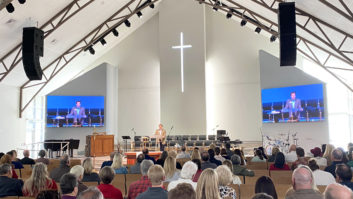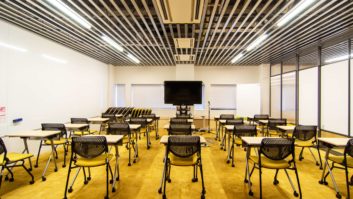
Michał Popławski, technical sales manager at Renkus-Heinz, discusses the value of digitally steerable audio solutions and why the market may be underestimating their benefits…
Self-powered, beam steerable speakers are a proven solution for delivering significant improvements to communication in the most challenging acoustical spaces. These loudspeakers are regarded as the cutting-edge solution for clarity and intelligibility. When it comes to placing sound, digitally steerable solutions may be the only answer. However, we may still underestimate the value of digitally steerable solutions. Intelligible messages are critical; it is important that the message is clearly understood the first time, for instructional and emergency scenarios in public buildings and transportation hubs. If the cost associated with missed messages due to intelligibility issues was a line item, it would be considerable.
Why digital beam steering?
The biggest challenge is designing a system that will have a high direct to reverberant sound ratio. Practically it can be difficult to achieve this with conventional loudspeakers. With beam steering technology it’s possible to aim sound precisely where it’s needed, while avoiding unwanted reflections from ceilings or walls. Every listener within a defined space receives direct sound without the detrimental effects of reflection on intelligibility.
Beam steerable loudspeakers can reduce the overall costs of a system, and offer a number of advantages over conventional Constant Voltage distributed systems with fewer speakers covering larger areas with improved intelligibility. Fewer, easier to install loudspeakers substantially reduce installation and maintenance costs.
The challenge in PA/VA
The requirement for speech intelligibility is becoming law and being written into legislation. We must provide the features required to meet worldwide standards. Examples of these standards and codes of practice: EN54, NFPA, BS5839 and EN50849.
Sound reinforcement systems in public spaces must meet a minimum Speech Transmission Index (STI) score for public safety reasons. While the EN54 standard excludes self-powered units, for now, there are special cases allowing these unique loudspeakers to be a part of the evacuation system. In fact, there are a number of features that self-powered, beam steerable loudspeakers can offer to help to make an exception and allow these loudspeakers to be used as the main PA in voice alarm system. Learning from many successful projects – it has been possible to define and develop features, which provide strong benefits and, actually, are core to the solution. As part of a PA/VA system in critical applications the beam steerable loudspeaker also needs to guarantee complete system integrity.
Consider the following benefits of such a setup:
Digital audio and network – digital audio has been a standard for many years, but networkable loudspeakers that can be easily integrated with IT infrastructure are still considered to be a novel solution. If the distance to the loudspeaker is long, it is much simpler to supply mains voltage locally and run a network cable directly to the loudspeaker. Networkable loudspeakers can be a simple additional network device that can be accessed remotely using conventional network equipment. With propriety software, or a custom-tailored API, many different parameters can be remotely controlled, like power on or standby, volume, presets, equalisation. They can also be remotely monitored, gaining insight into power supply voltages, temperature, faults, signal presence, network status, etc.
Fiber optic is an option – some applications of networked audio require cable runs in excess of the 100-meter limitation of copper Ethernet. To meet the needs of these installations, it is possible to offer a fiber optic connection directly to the self-powered loudspeaker. Networkable loudspeakers, especially audio over a network require attention to security as well. This is where an application such as Dante Domain Manager comes into play – its built-in security layer helps to protect the system from unwanted changes.
Redundant input – if the main digital audio signal fails, the amplifier can instantly switch to the backup input, which can be an independent analogue feed. The fail-over is immediate and inaudible, adding an extra layer of redundancy.
API / Fault Relay – the API gives the ability to write and/or read specific parameters of the self-powered loudspeaker. The end-user/maintenance engineer can be informed about the status of the network, amplifier, signal, and the transducers themselves, all in real-time. There can be an extra layer of remote monitoring outside the network as loudspeakers feature a Fault Relay. A Normally Closed (NC) or Normally Open (NO) relay reports if the mains voltage drops below the operational level, if the amplifier temperature is too high, or if there is DSP failure. Once an issue occurs, and it is reported to the central unit, it’s easy to troubleshoot the system from there. By running software that keeps the log file writing on the hard drive it is easy to understand the origin of the problem in the system and solve it.
DC power option – beam steerable speakers with this option have a DC power connector. The DC power can either be a secondary, backup power source or, if mains power is unavailable, the DC can be the primary power for the loudspeaker. When used as a backup power source, the loudspeaker will run on mains voltage until it drops below the normal AC voltage range, down to 90-95 volts. At that time, the amplifiers will instantly switch to the DC power. If the mains voltage is restored, they will switch back to the mains power as soon as it exceeds 95 volts.
Pilot Tone/Open Coil Test – Monitoring signal presence and transducer health is key in Voice Alarm applications. The impedance of the transducers can be measured by triggering an open-coil test. The amplifier will send a sine wave tone to each of the transducers and measure the impedance. The result of the test is a status flag for each component tested. These open-coil tests can be scheduled before or after any event in the venue. At the same time, the pilot tone can be sent to the input of the loudspeakers and then a flag can be raised over a network (API) if the signal is there or not. This is extremely useful to monitor entire signal flow, from a microphone up to the loudspeaker’s amplifier and transducers themselves, as it is required by BS5839-8 norm.
Redundant loudspeaker array – larger loudspeaker arrays can be constructed using two or more master modules. Each of the master modules receives power, network, digital audio, analogue audio and fault relay connection. When a column within the array is down or in a fault state, the remaining columns remain functional and still deliver audio. The API could automatically recall preset on the working columns to adjust the needed coverage.
Weatherised enclosures – the exact nature of the treatment varies with cabinet types and construction. Enclosures constructed from multiply hardwood are finished with a shell of durable, gel-coated fiberglass that is virtually impervious to harsh environments. The multiply hardwood is chosen for its durability and low moisture absorption characteristics. Other extruded aluminum enclosures are finished in durable paint. Other considerations, such as unique three-layer protective grilles and corrosion resistant hardware can also be applied to loudspeakers.
Each of these ideas improve the outcomes one would hope to gain from a Voice Alarm system and, in the end, make a location safer for those in attendance. Further, they should be applied to an increasing number of applications in the audio world. With digitally steerable solutions bringing many benefits to the table, one simply can’t leave out the consideration of how they fit in any integration.







